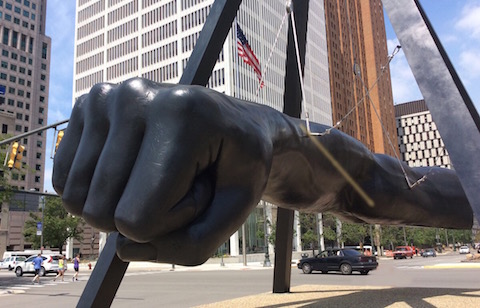Mudlark Flash No. 111 (2017)
Diane DeCillis

Monument to Joe Louis, photograph from Daily Detroit
The Fist on Jefferson Avenue
Meets Isaac Newton
Newton’s cradle demonstrates conservation of momentum and energy
via a series of swinging spheres. When one on the end is lifted and released,
it strikes the stationary spheres; a force is transmitted pushing the last one upward.
— Wikipedia
If you drive down Jefferson near the banks
of the Detroit river, you can’t miss the massive
24-foot-long, 8,000-pound sculpture, a forearm
that cuts through the urban landscape
with the force Joe Louis used to knock out
Max Schmeling. Dubbed The Fist, this “Monument
to Louis” might have taught Newton
a thing or two. Imagine pulling back the bronze arm
to launch an unstoppable forward motion,
a hook, a cross, uppercut-combos coming at you
again and again. His fists, fastest in history,
traveled mere inches ending in explosions
that could paralyze. His moves, efficient,
accurate.
I’ve seen Joe’s hands, felt his warm grip
when we stood up at a friend’s Vegas wedding in the 70’s.
Dressed in elegant white he spoke in a soft tenor,
had tender eyes. Eyes of a boy who lost his father
at the age of four, someone ready to give a hand,
give away all his cash, even when it meant
living in poverty.
I wish I’d talked to him more,
but I was young, ready to waste perfectly good
moments, thinking, like a pendulum, they’d return.
Suspended in a pyramidal frame, the hefty Fist
never sways, but does set the mind in motion.
Some say it looks cocked, an in-your-face jab,
head on, like a truck rolling off the Rouge,
others see it as protective, ready to defend
the city that has taken its share of blows.
Close
When NPR announced Mars will appear larger in the sky tonight, that its orbit will bring it closer to earth, I thought of the times I’ve heard you can almost touch it, the misses and near-misses, the lingering before yes or no— marriages, children, flights that could have gone either way. I thought of the trajectory of roots, old trees, patches of land inhabited by families over centuries—the silent march of footprints. And the word belonging, how the towering pines in our yard belong to us—used to belong to someone else, and will belong to others who will claim them as their own. I thought of the words when we are gone, how we travel among our own swath of humanity, share the same news, moments that will define our eventual history. Years ago, my husband showed me Mars through his telescope— stars and planets I’d never seen simply because I never looked, an unfathomable wilderness that made me feel safer just knowing there was more. The news that followed Mars was of the demise of a small boat crammed with five hundred human beings, their weight, the weight of their longing, too heavy for the saran of saltwater stretched to hold the words: sistermotherfatherbrotherbabydaughterson. How with no space between them they became one word, refugees unable to realize the dream they could almost touch. Now, I’m thinking about the difference between night and day how day is being and night is searching— and the sky—all that room.
Diane DeCillis writes at her desk in West Bloomfield, Michigan. Her poetry collection, Strings Attached (Wayne State UP, 2014), is a Michigan Notable Book for 2015, won The 2015 Next Generation Indie Book Award for poetry, and was a finalist for the Forward Indie Fab Book Award for poetry. Her poems and essays have appeared in CALYX, Evansville Review, Minnesota Review, Nimrod International Journal, Connecticut Review, Gastronomica, Rattle, Slipstream, Southern Indiana Review, William and Mary Review, and numerous other journals.